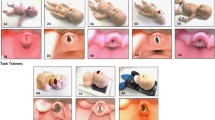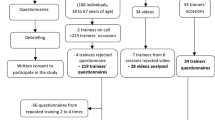Abstract
The neonatal resuscitation program (NRP) has been developed to educate physicians and other health care providers about newborn resuscitation and has been shown to improve neonatal resuscitation skills. Simulation-based training is recommended as an effective modality for instructing neonatal resuscitation and both low and high-fidelity manikin simulators are used. There is limited research that has compared the effect of low and high-fidelity manikin simulators for NRP learning outcomes, and more specifically on teamwork performance and confidence. The purpose of this study was to examine the effect of using low versus high-fidelity manikin simulators in NRP instruction. A randomized posttest-only control group study design was conducted. Third year undergraduate medical students participated in NRP instruction and were assigned to an experimental group (high-fidelity manikin simulator) or control group (low-fidelity manikin simulator). Integrated skills station (megacode) performance, participant satisfaction, confidence and teamwork behaviour scores were compared between the study groups. Participants in the high-fidelity manikin simulator instructional group reported significantly higher total scores in overall satisfaction (p = 0.001) and confidence (p = 0.001). There were no significant differences in teamwork behaviour scores, as observed by two independent raters, nor differences on mandatory integrated skills station performance items at the p < 0.05 level. Medical students’ reported greater satisfaction and confidence with high-fidelity manikin simulators, but did not demonstrate overall significantly improved teamwork or integrated skills station performance. Low and high-fidelity manikin simulators facilitate similar levels of objectively measured NRP outcomes for integrated skills station and teamwork performance.
Similar content being viewed by others
References
American Academy of Pediatrics. (2011). Textbook of Neonatal Resuscitation (NRP). Dallas, TX: American Heart Association.
Beaubien, J. M., & Baker, D. P. (2004). The use of simulation for training teamwork skills in healthcare: How low can you go? Quality and Safety in Health Care, 13(Suppl 1), i51–i56.
Bradley, P. (2006). The history of simulation in medical education and possible future directions. Medical Education, 40, 254–262.
Brown, J. S., Collins, A., & Durguid, P. (1989). Situated cognition and the culture of learning. Educational Researcher, 18(1), 32–42.
Campbell, D., Barozzino, T., Farrugia, M., & Sgro, M. (2009). High-fidelity simulation in neonatal resuscitation. Paediatrics and Child Health, 14(1), 19–23.
Canadian Pediatric Society. (2012). FAQs. Retrieved from: http://www.cps.ca/nrp-prn/faqs.
Carbine, D., Finer, N., Knodel, E., & Rich, W. (2000). Video recording as a means of evaluating neonatal resuscitation performance. Pediatrics, 106(4), 654–658.
Chamberlain, D., & Hazinski, M. F. (2003). ILCOR advisory statement: Education in resuscitation. Resuscitation, 59, 11–43.
Cook, D. A., Hatala, R., Brydges, R., Zendejus, B., Szostek, J. H., Wang, A. T., et al. (2011). Technology-enhanced simulation for health professions education: A systematic review and meta-analysis. JAMA, 306, 978–988.
Curran, V. R., Aziz, K., O’Young, S., & Bessell, C. (2004). Evaluation of the effect of a computerized training simulator (ANAKIN) on the retention of neonatal resuscitation skills. Teaching and Learning in Medicine, 16(2), 157–164.
Curran, V. R., & Fleet, L. (2012). An exploratory study of factors influencing resuscitation skills retention and performance amongst health providers. Journal of Continuing Education in the Health Professions, 32(2), 126–133.
Davis, D., Mazmanian, P. E., Fordis, M., Van Harrison, R., Thorpe, K. E., & Perrier, L. (2006). Accuracy of physician self-assessment compared with observed measures of competence: A systematic review. JAMA, 296(9), 1094–1102.
Davoudi, M., Wahidi, M. M., Zamanian, R. N., & Colt, H. G. (2010). Comparative effectiveness of low- and high-fidelity bronchoscopy simulation for training in conventional transbronchial needle aspiration and user preferences. Respiration, 80(4), 327–334.
Dunn, S., Niday, P., Watters, N. E., McGrath, P., & Alcock, D. (1992). The provision and evaluation of a neonatal resuscitation program. Journal of Continuing Education in Nursing, 23(3), 118–126.
Ergenekon, E., Koç, E., Atalay, Y., & Soysal, O. (2000). Neonatal resuscitation course experience in Turkey. Resuscitation, 45(3), 225–227.
Eva, K. W., & Regehr, G. (2005). Self-assessment in the health professions: A reformulation and research agenda. Academic Medicine, 80(10), S46–S54.
Flin, R., & Maran, N. (2004). Identifying and training non-technical skills for teams in acute medicine. Quality and Safety in Health Care, 13(Suppl 1), i80–i84.
Frankel, A., Gardner, R., Maynard, L., & Kelly, A. (2007). Using the communication and teamwork skills (CATS) assessment to measure health care team performance. Joint Commission Journal on Quality and Patient Safety, 33(9), 549–558.
Gay, L. R. (1996). Educational research: Competencies for analysis and application (5th ed.). Englewood Cliffs, NJ: Prentice-Hall.
Glaser, B. G., & Strauss, A. L. (1967). The discovery of grounded theory: Strategies for qualitative research. New York, NY: Aldine de Gruyter.
Greiner, A. C., & Knebel, E. (2003). Health professions education: A bridge to quality. Washington, DC: The National Academies Press.
Halamek, L., Kaegi, D., Gaba, D., Sowb, Y., Smith, B., & Howard, S. (2000). Time for a new paradigm in pediatric medical education: Teaching neonatal resuscitation in a simulated delivery room environment. Pediatrics, 106(4), 1–6.
Hoadley, T. (2009). Learning advanced cardiac life support: A comparison study of the effects of low- and high-fidelity simulation. Nursing Education Perspectives, 30(2), 91–95.
Issenberg, S. B., McGaghie, W. C., Petrusa, E. R., Gordon, D. L., & Scalese, R. J. (2005). Features and uses of high-fidelity medical simulations that lead to effective learning: A BEME systematic review. Medical Teacher, 27(1), 10–28.
Malec, J., Torsher, L., Dunn, W., Wiegmann, D. A., Arnold, J. J., Brown, D. A., et al. (2007). The mayo high performance teamwork scale: Reliability and validity for evaluating key crew resource management skills. Simulation in Healthcare, 2(1), 4–10.
Maran, N. J., & Glavin, R. J. (2003). Low- to high-fidelity simulation—a continuum of medical education? Medical Education, 37(Suppl. 1), 22–28.
Murphy, A., & Halamek, L. (2005). Simulation-based training in neonatal resuscitation. NeoReviews, 6(11), e489–e492.
Nelson, M., & Brown, C. G. (1984). CPR instruction: Modular versus lecture course. Annals of Emergency Medicine, 13(2), 118–121.
Norman, G., Dore, K., & Grierson, L. (2012). The minimal relationship between simulation fidelity and transfer of learning. Medical Education, 46, 636–647.
Perkins, G. (2007). Simulation in resuscitation training. Resuscitation, 73, 202–211.
Rodgers, D. L., Securro, S, Jr., & Pauley, R. D. (2009). The effect of high-fidelity simulation on educational outcomes in an advanced cardiovascular life support course. Simulation in Healthcare, 4(4), 200–206.
Scholz, C., Mann, C., Kopp, V., Kost, B., Kainer, F., & Fischer, M. R. (2012). High-fidelity simulation increases obstetric self-assurance and skills in undergraduate medical students. Journal of Perinatal Medicine, 40(6), 607–613.
Skidmore, M., & Urquhart, H. (2001). Retention of skills in neonatal resuscitation. Paediatrics and Child Health, 6(1), 31–35.
Stein, D. (1998). Situated learning in adult education. Columbus, OH. (ERIC Digest No. 195; ERIC Document Reproduction Service No. ED418250).
Tan, S. C., Marlow, N., Field, J., & Altree, M. (2012). A randomized crossover trial examining low- versus high-fidelity simulation in basic laparoscopic skills training. Surgical Endoscopy, 26(11), 3207–3214.
Teteris, E., Fraser, K., Wright, B., & McLaughlin, K. (2012). Does training learners on simulators benefit real patients? Advances in Health Sciences Education: Theory and Practice, 7(1), 137–144.
Thomas, E. J., Sexton, J. B., & Helmreich, R. L. (2004). Translating teamwork behaviours from aviation to healthcare: Development of behavioural markers for neonatal resuscitation. Quality and Safety in Health Care, 13(Suppl 1), i57–i64.
Woolliscroft, J. O., Galhoun, J. G., Tenhaken, J. D., & Judge, R. D. (1987). Harvey: The impact of a cardiovascular teaching simulator on student skill acquisition. Medical Teacher, 9(1), 53–57.
Yaeger, K., & Arafeh, J. (2008). Making the move from traditional neonatal education to simulation-based training. Journal of Perinatal and Neonatal Nursing, 22(2), 154–158.
Acknowledgments
NRP training offered in conjunction with the study was only possible due to the collaborative efforts of: the Perinatal Program NL; Ms. Darlene Toope (neonatal educator); Ms. Diana Parsons (NRP instructor); Undergraduate Medical Education (UGME), Faculty of Medicine, Memorial University (Ms. Paula Mullins-Richards and Ms. Wandalee Cole); Medical Simulation Unit, Faculty of Medicine/Eastern Health (Ms. Joanne Hapgood and Ms. Sherry Pritchett-Kelly); Laerdal Canada (Mr. Scott Spearn, Vice-President and General Manager); and College of the North Atlantic, St. John’s, NL for providing an extra manikin and equipment.
Author information
Authors and Affiliations
Corresponding author
Rights and permissions
About this article
Cite this article
Curran, V., Fleet, L., White, S. et al. A randomized controlled study of manikin simulator fidelity on neonatal resuscitation program learning outcomes. Adv in Health Sci Educ 20, 205–218 (2015). https://doi.org/10.1007/s10459-014-9522-8
Received:
Accepted:
Published:
Issue Date:
DOI: https://doi.org/10.1007/s10459-014-9522-8




